| 1 | Florida’s strongest snake venom |
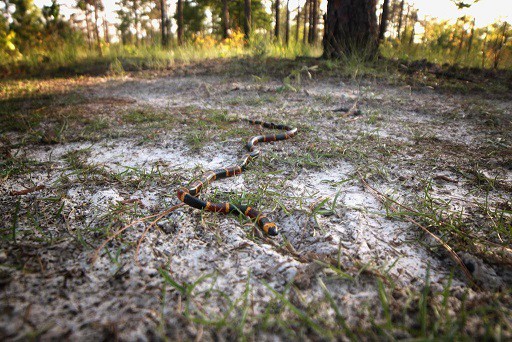
Florida has 6 snake species with venom capable of seriously damaging a human being. Three of these are rattlesnakes, with the pygmy rattlesnake being the most commonly sighted by human beings. The eastern diamondback appears all the state, but is sparsely distributed, sticking to untouched natural areas. The timbre rattlesnake is most concentrated in the north. Then we have the Florida cottonmouth, found in swamps and lakes all over the state. Its cousin the copperhead lives in leafy forests, but mainly in the north…
…which brings us to Florida’s last venomous snake, and the deadliest when drop-for-drop venom is considered. We’re talking about the eastern coral snake (Micrurus fulvius), which is found all over Florida, from the panhandle to Miami. It’s also a common species in Georgia and South Carolina.
This is never a species which will invade your bedroom, nor one you’ll find outside a Walmart creeping up on people fiddling around for their car keys. The eastern coral snake appears mainly in woodlands and spacious forests. They’re capable of swimming, but appear in water bodies only rarely. As for their venom, it receives an LD50 potency score of 0.2mg, which easily dwarfs Florida’s next most dangerous snake, the eastern diamondback rattlesnake (1.2mg).
| 2 | The real rhyme inspiration |
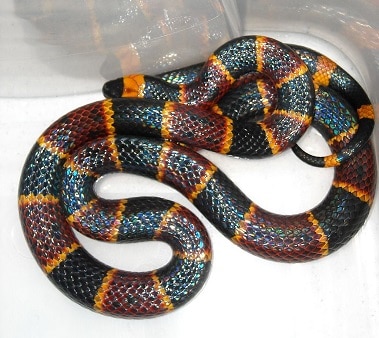
For decades before the internet became an omnipresent source of knowledge, kids were taught simple sayings in order to dodge venomous snakes. Most are variations on a similar theme, including “red touches yellow, kill a fellow”, or “red touches black, venom lack”.
In some places, this saying could be deadly; the South American coral snake has black bands touching red, and injects a corrosive venom. But in Florida, the statement is completely accurate. The protagonist in the saying is the scarlet snake, a white, red and black snake which lives in secretive burrows and possesses no venom. The main antagonist is the eastern coral snake.
Its colours consist of black, red, yellow, and another easy ID feature is its jet black nose, compared to the red nose of the scarlet snake or harmless scarlet kingsnake. In fact, it’s more like their entire face that’s black; it’s hard to recognise that you’re even looking at a face sometimes.
Eastern coral snakes have a very small head as well, giving them the appearance of a colourful worm. As for their length, this snake measures 80cm on average, with the largest on record being 129.5cm in 1996.
| 3 | Brain-frying neurotoxins |
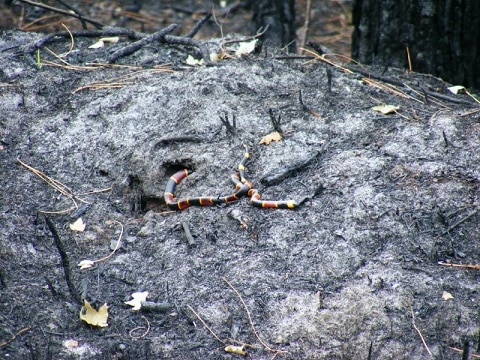
Eastern coral snakes are a shy snake, preferring to live their lives rather than bite picnickers just for the sake of it. That said, they still bite 100 victims per year on average. Few die, with only 1 death occurring (in 2006) since antivenin was invented in the 1960s, and two more happening in the 1950s.
Post bite, eastern coral snake venom has a sneaky 12 hour delay factor. When the symptoms finally arrive, they come in a flood of neurological ailments, like most coral snakes. That means massive disruption of the transmissions between brain and muscle, brain and lungs, brain and heart, and more. The average victim experiences slurred speech, double vision, and drooling, followed by muscular paralysis. Dizziness, confusion, and euphoria are also found in doctors’ notebooks.
There’s a few saving graces though. At LD50 0.2mg, the venom isn’t quite the deadliest in America, compared to 0.06mg for a tiger rattlesnake. The venom yield is also low, at just 3-5mg (versus 50-150mg), and that’s partly why they kill so few people.
| 4 | 60% of bites are dry |
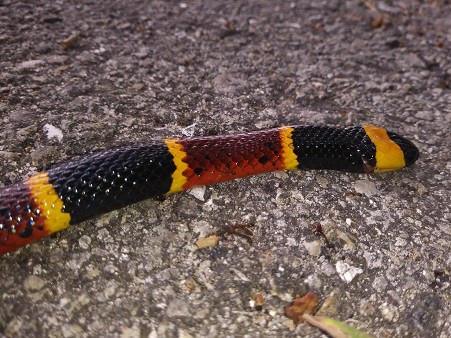
Another safety buffer is that 60% of eastern coral snake bites are dry, with no venom entering the victim’s body. This is unusually low. A flash of yellow against red isn’t quite the death sentence suggested by catchy folklore rhymes, but it’s no cakewalk either. The venom is confirmed to contain hyaluronidase, a “spreading factor” that helps the venom to diffuse by dissolving hyaluronic acid in the skin.
This species is the exact opposite of the Mozambique spitting cobra, in that they cause neurological problems, but virtually no skin tissue death (necrosis). The bite marks are often impossible to notice except for a slight swelling, helped by their small fang size. The main symptoms are intense pain around the puncture, and paresthesia, hot tingling sensations. The first symptom is often ptosis, drooping of the upper eyelid.
Originally, the Texas coral snake was an eastern coral subspecies, but in 1991, they were separated into two full species. One reason was that the eastern version has significantly more toxic venom.
| 5 | Very consistent venom |
In the recent death from 2006, a Hispanic man was lying in a tent drinking beer, when his future killer slithered in uninvited. Victim 2 grabbed the snake from behind while victim 1 smashed it over the head with a beer bottle. Both men suffered bites, but while victim 2 checked into hospital and later made a full recovery, victim 1 stayed put. He continued to drink beer, and 2 hours later, his friends reported that he had a seizure and stopped breathing. The man was already dead when the emergency services pulled up. The autopsy found no damage to his heart or coronary arteries, but a moderate amount of frothy blood in his lungs.
Whether you’re in North Carolina or Florida, the symptoms will probably be similar, as a 2015 study found that eastern coral snakes had very consistent venom across their territory. The eastern diamondback rattlesnake was the opposite, with significant variety in individual toxins. The asp viper of France is another one with variety; this species normally lacks neurotoxins, except for one small enclave near Nice.
| 6 | Diet: mostly other snakes |
The eastern coral snake relies on reptiles for its calories, and particularly armless, legless reptiles with long bodies and flecking tongues. In other words, the eastern coral snake munches on fellow snakes. According to sightings in 1938, 1944, and 1970, they’ll happily eat members of their own species.
Dead snakes are also no problem, as a viral video proved in 2019. Character 1 was an eastern racer, mysteriously hanging dead from a thorny rose bush, probably after being dropped by a bird. Character 2 was an eastern coral snake barely larger than the racer. Micrurus fulvius is a poor tree climber, but this snake has just summoned up enough skills to climb the bush.
As it attempted to swallow the racer headfirst, character 3 entered the scene: a yellowjacket wasp, which relentlessly stung the coral snake for no obvious reason. The angry wasp persisted, and the coral snake finally gave up, but returned to the rose bush hours later for another go, as shown in a second video. Both videos were filmed in a Gainesville, Florida garden.
| 7 | Local snakes on its menu |
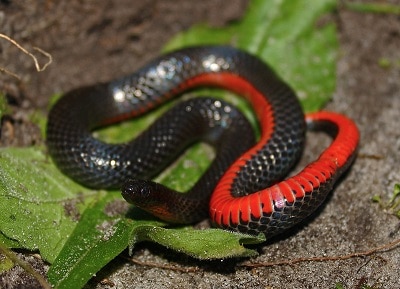
The eastern coral snake’s love for other snakes (well, their taste anyway) is believed to be why their venom evolved neurotoxins, as it was so important to paralyse them immediately. The paralysis kicks in far faster in snakes than humans, due to their smaller body size. Species they’ve been spotted eating include…
Rough green snakes – a bright green, very thin snake measuring 1 metre which lives in meadows, and often climbs trees. Range: the eastern USA, from Texas to Florida to coastal Maine.
Eastern racers – an intelligent blue-grey snake measuring 52-150cm. This is the snake most commonly found in Floridian homes. Range: most of the USA.
Mud snakes – black and red, the colour of a scorching magma flow. Mud snakes dwell in streams and swamps, always dodging alligators. Range: limited to the US southeast.
Black swamp snake – lives in heavily vegetated swampland. Much smaller at 25-38cm, so easier to slurp down. Range: Georgia, Alabama, Florida and the Carolinas.
Eastern coral snakes also eat lizards sometimes, and one confirmed is the eastern glass lizard (Ophisaurus ventralis).
| 8 | Hunted by keen-eyed hawks |
There’s a little thing called the food chain, however, and the eastern coral snake is nowhere near the top. In fact, they’re literally far from the top, as there are predatory birds constantly circling their heads.
American kestrels and red-shouldered hawks are two confirmed predators, swooping down on the snakes when they dare to leave their leafy dens. Their strategy is to aim for the head, sometimes leaving the snake streaked with blood if it manages to escape.
The most notorious snake predator in the USA is the red-tailed hawk. Their staple is the non-venomous gopher snake, which comprises approximately 18% of their diet near the Columbia river. Micrurus fulvius is a rare, trickier operation, as its venom could easily wipe the bird out completely, just for the sake of a few calories. It often does, as a 1989 report described how one red-tailed hawk succumbed to the venom and died with an eastern coral snake still in its talons. The snake was already partially eaten, so the toxins had clearly taken time to spread.
| 9 | Missing from the north |
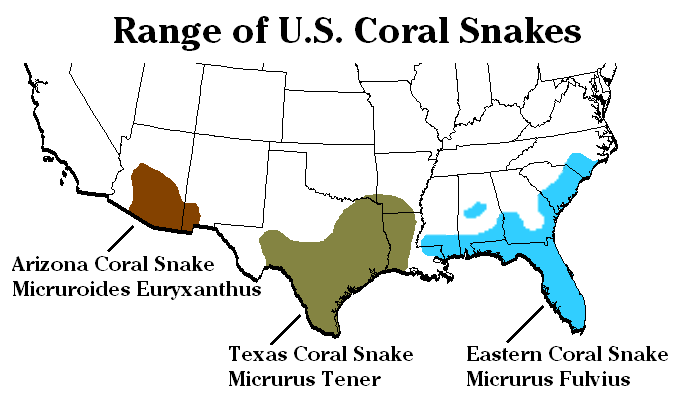
50 years ago, the eastern coral snake had a far larger range. But recently, those in Texas have been split into a separate species (Micrurus tener) rather than subspecies, and the furthest west the real eastern coral snake now lives is southern Louisiana.
As you journey eastwards, the snake grows more and more common until you reach its true strongholds: Florida and Georgia. Within those states, eastern coral snakes specialise in several habitats, including slash pine, wireglass flatwoods, high pine, scrub oak, and live oak hammock. Wide, spacious forests with sparse vegetation are their strongholds, including tropical broadleaf forests in Florida.
Eastern coral snakes are poor tree climbers, and are never seen dangling from branches like boas, but they compensate with excellent burrowing skills. Eastern coral snakes spend much of their day buried in soil, and are also spotted below rotting logs, leaf litter and rock piles. You probably won’t be chased by this snake across the forest floor – you’re more likely to brush against one with your boot.
| 10 | Chews its venom into victims |
Micrurus fulvius isn’t a snake which leaps and bites hard, before instantly withdrawing and waiting for their prey’s death. Instead, they’re a chewer, holding onto prey and biting repeatedly, since they only release small venom quantities with each bite. The venom glands aren’t attached to the fangs, but positioned adjacently. Instead of injecting venom directly, eastern coral snakes are forced to create two deep bite holes and allow the venom to seep in.
That said, even a scratch from this snake’s teeth has the potential to unleash neurological havoc in humans. Stealth is another move in their repertoire, as the black featureless face is designed to trick birds into thinking they’re attacking the tail, and stopping in uncertainty mid-swoop. This gives the snake precious seconds to fight back.
For reasons they’re not revealing, eastern coral snakes always eat their prey headfirst. Only one exception has been recorded: the black swamp snake sighting.
| 11 | Moves exclusively by day |
Eastern coral snakes are a strictly diurnal snake, almost never venturing out at night. In 1983, scientists wandered through the humid Florida countryside and picked up 27 members of the species. The earliest they found was 85 minutes after sunrise, and the latest was 15 minutes before sunset. It didn’t matter whether the skies were sunny, overcast, or drizzly – the snakes always stuck to their daylight rule.
Fortunately, this species doesn’t have a death wish to kill anyone encroaching on their territory. Eastern coral snakes usually only bite people when handled overconfidently or played with. In fact, they’re a secretive snake which is difficult to find, although not quite as secretive as their nursery rhyme compatriot the scarlet snake. The vast majority of people, whether in Floridian forests or North Carolina fields, spot them in spring and autumn.
Summer is almost barren for sightings, and there’s a good reason, as from April-August, eastern coral snakes become totally inactive from 10:00 to 16:00, restricting their activity to 7:00-9:00 and 16:00-17:30. In March, and from September to November, they stay on the prowl for much longer, and their midday break is restricted to 13:30 to 16:00.
